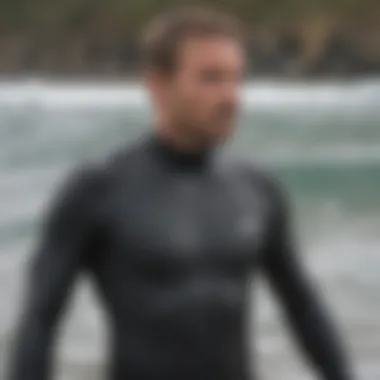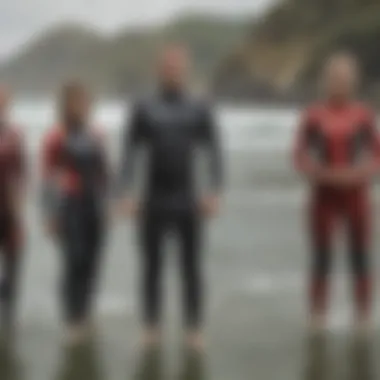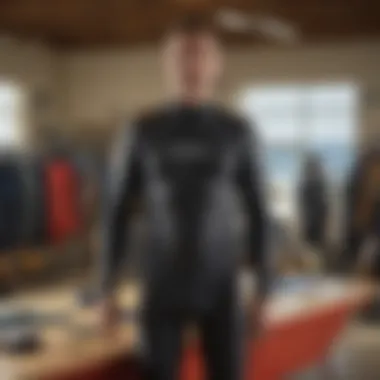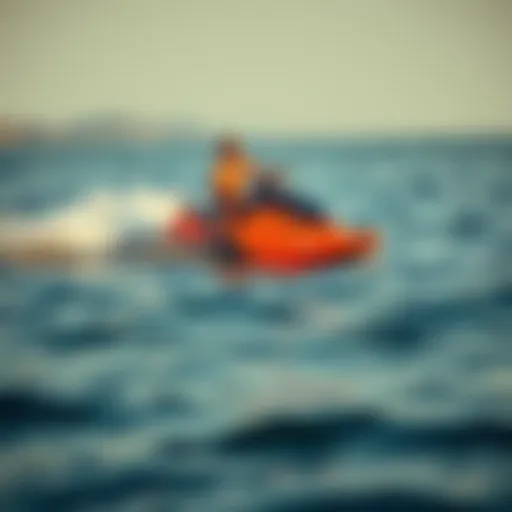In-Depth Review of O'Neill Wetsuits on the Market


Intro
In the ever-evolving realm of water sports gear, O'Neill wetsuits stand out not only for their distinctive style but also for their commitment to innovation and performance. For surfers, paddleboarders, kitesurfers, and those who teach these exhilarating activities, having the right wetsuit can make the difference between a blissful day on the water and a cold retreat to shore. This guide will navigate through the myriad options available, ensuring you’re well-informed to select the perfect suit tailored to your needs.
As we sift through the various attributes of O'Neill wetsuits, let’s dive headfirst into the essentials you need to consider when cranking up your aquatic adventures. The goal here is to present you with a comprehensive analysis, helping those who seek not just to buy, but to enhance their overall experience on the water.
Gear Essentials
When it comes to water sports, the right gear is not merely an accessory; it’s integral to your performance, comfort, and safety. O'Neill wetsuits combine functionality with cutting-edge design, offering a variety of options to suit diverse water conditions and activities.
Top Picks for Watersports Equipment
- O'Neill Psycho Tech
A top-of-the-line choice, this wetsuit features TechnoButter 3 neoprene, providing flexibility and warmth. Ideal for colder waters, it utilizes GlideSkin seals which prevent water from entering, keeping you snug and dry. - O'Neill Hyperfreak
If it’s lightness and stretch you’re after, the Hyperfreak might just be your ticket. With its F'Drive technology, it claims to elevate your riding experience, stitching up comfort with durability. - O'Neill Reactor
For those just stepping into the water world or looking for an economical option, the Reactor offers good quality without breaking the bank. Its standard design ensures you stay comfortable during long sessions in the water.
However, choosing the right wetsuit depends heavily on your body type and the conditions you'll face. The snugger the fit, the better the thermal regulation and hydrodynamics. Don't forget to check for features like reinforced knees, proper zipper placements, and drying time; these details can significantly impact your experience.
Maintenance and Care Tips for Gear
Taking care of your wetsuit can prolong its life and performance. Here are a few handy tips:
- Rinse After Use: Always rinse your wetsuit in fresh water to remove salt and sand.
- Dry Properly: Hang it upside down in a shaded area to avoid direct sunlight which can degrade the material.
- Store Correctly: Rather than folding, hang it on a wide hanger to prevent creases, which may weaken the fabric over time.
- Avoid Excessive Heat: Keeping it away from car heaters or direct stoves is essential; high temperatures can lead to irreversible damage.
By following these maintenance tips, your O'Neill wetsuit can serve you well for many seasons, preserving both its functionality and aesthetics.
Techniques and Tips
While having the right wetsuit boosts confidence on the water, knowing how to handle different scenarios effectively is equally paramount.
Beginner Tips for Each Watersport
- Surfing: Before hitting the waves, practice popping up on your board at home. This will build muscle memory for balance.
- Paddleboarding: Keep your feet shoulder-width apart and remember to engage your core for better stability.
- Kitesurfing: Focus on understanding wind patterns. A good sense of wind direction is crucial for taking off and landing safely.
Advanced Techniques for Skill Enhancement
For those looking to take their skills to the next level, consider these:
- Surfing: Learn to read waves. Understanding the surf conditions will increase your success rate when catching them.
- Paddleboarding: Master the cross-step for better maneuvering in challenging waters.
- Kitesurfing: Work on your transitions; smooth transitions can elevate your performance significantly.
No matter if you are a novice or seasoned expert, improving skills will enhance your fun and safety on the water.
"A great wetsuit is your garment; without it, the water becomes a barrier instead of a gateway to adventure."
Introducing O'Neill Wetsuits
The world of watersports is a thrilling and demanding one, where the right gear can make or break the experience. At the heart of this sphere lies the wetsuit, a crucial piece of equipment for enthusiasts ranging from surfers to kitesurfers. O'Neill wetsuits emerge as one of the frontrunners in this market, promising both performance and reliability. In this section, we will delve into what makes O'Neill a coveted brand and why many water sports aficionados turn to it for their wetsuit needs.
Overview of the Brand
O'Neill represents a powerhouse in the watersports industry, synonymous with innovation and style. Founded in the early 1950s by Jack O'Neill, the brand began in a modest surf shop in San Francisco. Originally designed to combat the chilly Pacific waters, O'Neill wetsuits pioneered the use of neoprene, setting a standard that many would follow. Today, their products are not only functional but, thanks to various designs, are fashion-forward as well.
Their commitment to quality shines through in every wetsuit produced. Whether it's the full wetsuits for those diving deep or the shorty wetsuits perfect for summer surfing, O'Neill caters to a variety of needs and preferences. Other than just being popular for their performance, they have transformed wetsuits into a lifestyle choice, influencing both function and fashion on the water.
Historical Background
The journey of O'Neill began with a simple problem: Jack O'Neill wanted to surf without feeling like he was freezing. By 1952, he created the first wetsuit, which was a revolutionary move in the surfing community. His invention quickly gained traction among surfers who were eager to extend their stints in the water and enjoy the sport year-round. O'Neill’s innovation did not just stop at wetsuits; it flowed into the creation of surfboards and swimwear, offering a wide array of products to cater to water sports enthusiasts.
Over the decades, O'Neill continued to enhance its wetsuit lineup, merging technology with athlete feedback. They embraced developments that improved suit flexibility, warmth retention, and durability, while maintaining a keen eye on styling.
It's essential to recognize that O'Neill's impact extends beyond product development. The brand has championed sustainability initiatives and education in the sport, participating in numerous environmental projects to protect the very waters surfers adore.
Types of O'Neill Wetsuits Available
When considering O'Neill wetsuits, it's crucial to understand the different types available. Each variant serves specific needs and conditions, catering to various water sports enthusiasts. By breaking down the key offerings—full wetsuits, shorty wetsuits, and hooded wetsuits—one can identify the best fit for personal activities, climate, and levels of insulation required. This understanding can significantly enhance not just comfort but also performance in the water.
Full Wetsuits
Full wetsuits are the heavy hitters when it comes to thermal protection. They typically cover the entire body, providing insulation in colder waters, making them ideal for surfers, divers, and anyone who spends considerable time in chilly temperatures. A well-fitting full wetsuit locks in body heat and allows for better movement over a broader range of temperatures. O'Neill’s full wetsuits use high-quality neoprene materials, ensuring flexibility and durability.


Important Insight: A quality full wetsuit can keep you warm in waters as cold as 50°F (10°C).
Benefits of full wetsuits include:
- Warmth: Retains body heat effectively.
- Protection: Shields from UV rays and marine life.
- Versatility: Suitable for various water activities, from surfing to paddleboarding.
However, it’s essential to focus on the right thickness. For example, say you’re planning to hit the waves in more temperate regions. A 3/2mm thickness might do the trick. In harsher conditions, consider upgrading to a 4/3mm wetsuit for added warmth.
Shorty Wetsuits
Shorty wetsuits, often referred to as spring suits, are designed for warmer conditions. These wetsuits feature short sleeves and legs, providing a snug fit while giving freedom of movement and body ventilation. They are ideal for spring and summer usage, particularly for activities like kite surfing or paddleboarding where flexibility and comfort are prioritized over insulation.
With shorty wetsuits, practitioners can enjoy:
- Breathability: Keeps you cool in warmer waters.
- Enhanced Functionality: Provides more leniency for arm motion.
- Easy to Wear: Simple to get into and out of, ideal for quick sessions.
While a shorty may not offer the same thermal protection as its full counterpart, it's perfect for those sunny beach days or light water activities where getting wet is part of the fun.
Hooded Wetsuits
Hooded wetsuits are typically favored during winters or in especially cold waters. They combine the benefits of full wetsuits with an added layer of head protection, which is often overlooked. O'Neill’s hooded options are engineered to ensure maximum insulation, with the design eliminating any gaps that could let cold water in. They are quite popular among surfers who seek comfort while battling frigid ocean temperatures.
Pros of using a hooded wetsuit:
- Full Coverage: Protects head, neck, and entire body from cold.
- Wind Resistance: The hood shields against wind chill, which can drain body heat fast.
- Comfort: Maintains warmth without the need for layering additional garments.
For those who spend significant time in waters where even the bravest fish prefer to stay shallow, a hooded wetsuit becomes a necessary companion, ensuring that warmth remains a priority.
Understanding the differences between these key types of O'Neill wetsuits is fundamental. It allows enthusiasts to make informed choices based on the conditions they’ll encounter, enhancing both safety and enjoyment while in the water.
Features of O'Neill Wetsuits
When it comes to selecting a wetsuit, understanding the features specific to O'Neill can be the difference between a pleasant day on the water and a frustrating one. The right wetsuit can enhance performance, provide comfort, and extend your time out in the elements. Let’s delve into some critical features that set O'Neill wetsuits apart.
Material Technology
The foundation of any wetsuit lies in its materials, and O'Neill takes this very seriously. They employ innovative materials that not only serve functional purposes but also cater to a variety of conditions. One standout is the use of neoprene, particularly the Super Stretch neoprene, which offers incredible flexibility while maintaining insulation. This is crucial for surfers and diver, as it allows them the freedom of movement necessary without feeling constricted.
Additionally, many models incorporate other advanced materials like TechnoButter or FluidFlex, known for their lightness and quick-drying properties. This tech is important, especially after surfing in cooler waters; nobody enjoys putting on a heavy, waterlogged suit after catching some waves.
"A good wetsuit is like a second skin, allowing you to do what you love without too much fuss."
Thermal Insulation
Thermal insulation is another pivotal feature of O'Neill wetsuits. It’s not just about staying warm; it’s about maintaining an ideal body temperature in varying water conditions. Depending on your activity level, being too hot can be as uncomfortable as being too cold. O'Neill achieves this delicate balance using a mix of insulation technologies.
For instance, the use of inner linings such as the O'Neill Firewall helps in retaining core heat, making those chilly morning sessions much more bearable. Additionally, their insulation materials are designed to keep water out as much as possible. When water seeps in, it can chill you faster than a dive off a board. That said, choosing the right thickness of insulation based on your environment is as essential as picking the right color!
Seam Construction
Seam construction is often an overlooked aspect, but it can make a world of difference in durability and comfort. O'Neill utilizes a variety of seam technologies, including flatlock seams for warmer water suits and glued and blind-stitched seams for the colder climates. Flatlock offers comfort against the skin, while the glued seams create a watertight seal, enhancing insulation.
The use of these advanced seams means fewer leaks and less wear and tear. Nothing is worse than finding a small tear after a great session; it's like finding a hole in your favorite shirt. Paying attention to seam type allows water sports enthusiasts to choose a wetsuit that fits their specific needs better.
Investing in the right features can elevate your experience, enabling you to push your limits, whether catching waves, exploring sea depth, or gliding across lakes. The features of O'Neill wetsuits cater directly to these needs, and it’s important to understand each element as you consider your purchase.
Selecting the Right Wetsuit
Choosing the right wetsuit is crucial for anyone keen on enjoying water sports, whether it's surfing, paddleboarding, or kitesurfing. A proper wetsuit not only enhances comfort but also significantly affects performance. An unsuitable fit or thickness can lead to discomfort or even affect physical agility in the water. Therefore, focusing on the specific elements of fit, thickness, and activity types is fundamental to maximizing your experience.
Understanding Fit
Getting the fit right is perhaps the most pivotal part when it comes to selecting a wetsuit. A wetsuit should hug your body snugly without being restrictive. It’s like putting on a second skin; you should hardly notice you’re wearing it while still feeling secure. Significant gaps can allow water to flow in and compromise insulation, making you chilly.
- Body Types: Different designs cater to various body shapes. Understanding your body type—whether slender, muscular, or more robust—will guide you in picking the right size and style.
- Try Before You Buy: If possible, try on different models. Feel how the material reacts against your skin when you bend, squat, or make any movements typical for your sport. It is best to make sure your wetsuit does not restrict any movement.
"A well-fitted wetsuit can make the difference between a great day out on the water and a miserable experience."
Choosing the Correct Thickness


The thickness of your wetsuit significantly impacts warmth and flexibility. Generally, the thicker the suit, the warmer it will keep you. However, thickness often comes at the expense of flexibility. Thus, finding a balance between warmth and maneuverability is vital according to the conditions where you plan to surf or paddle.
- Cold Water: In water temperatures below 60°F, a suit of 4/3mm or thicker is usually advised. For relishers of colder climates, consider 5/4mm options.
- Warm Water: Temperatures above 70°F could allow for thinner suits like 2mm or shorty styles.
- Seasonal Variability: Be mindful of the time of year. What works in summer may not suffice as conditions change in the fall or winter.
Assessing Activities
Different activities have unique demands on wetsuits. It’s critical to assess what type of water sports you’ll be doing to make the best choice.
- Surfing: Loading and unloading your board requires flexibility. Opt for suits that accommodate wide range of motion in the arms, like those with less bulk around the shoulders.
- Paddleboarding: Here, insulation can be less of a concern unless it’s particularly chilly. Focus more on how the suit floats and provides ease of movement instead.
- Kitesurfing: This sport demands a suit that won’t be too constraining while being able to withstand strong winds and wipes outs. Consider reinforced seams and a snug fit around the board.
Taking time to sink your teeth into these elements will better inform your choice, leading to improved comfort and enjoyment on the water. Selecting the right wetsuit goes beyond just pickin' a size off a rack; it’s about ensuring each outing is a memorable, enjoyable experience.
Pricing Strategies and Value
Understanding the pricing strategies and value of O'Neill wetsuits is crucial when it comes to making informed purchasing decisions. A wetsuit is an investment, and its pricing not only reflects its quality but also hints at the functionality and longevity that one can expect. Whether you're a surfer riding the waves, a paddleboarder cruising across the lake, or an instructor guiding others in the water, knowing how to navigate the pricing landscape can significantly influence your experience.
When examining the value associated with O'Neill wetsuits, several elements come into play. Firstly, the materials and technology used in crafting these wetsuits often set the baseline for their prices. Premium materials such as neoprene or innovative thermal technologies contribute to performance and durability, and understanding these aspects can illuminate why a wetsuit might come with a steeper price tag.
Secondly, brand reputation plays a significant role in pricing. O'Neill has built a solid standing over the years, and that trust translates into the pricing strategies they implement. Applying different pricing strategies can ensure customers feel they are receiving value without sacrificing quality. When a user corresponds with a brand that’s known for its reliability, it generates confidence in one's investment, knowing the wetsuit will stand the test of time under various conditions.
Finally, being aware of the fluctuations in prices during sales seasons or new product launches can lead to substantial savings. By keeping an eye on market trends and being educated on the value proposition of the wetsuits, customers can optimize their purchasing timeline to get the most bang for their buck.
Typical Price Ranges
O'Neill wetsuits generally fall within a range depending on the type, features, and technologies involved. For instance, a full wetsuit typically ranges anywhere from $200 to $500. Shorty wetsuits, which provide less coverage and are often used in warmer waters, are slightly less expensive, usually between $100 and $300. Meanwhile, hooded wetsuits, designed for colder environments, can command prices reaching upwards of $600.
Here’s a breakdown of what to expect:
- Full Wetsuits:
- Shorty Wetsuits:
- Hooded Wetsuits:
- Entry-level: $200 - $300
- Mid-range: $300 - $400
- High-end: $400 - $600
- Entry-level: $100 - $150
- Mid-range: $150 - $250
- High-end: $250 - $300
- Entry-level: $300 - $400
- Mid-range: $400 - $500
- High-end: $500 - $700
With this kind of range, making comparisons among different types can help in pinpointing the best fit for your needs and budget.
Promotional Offers
Throughout the year, O'Neill and its retailers often implement promotional offers which can make a significant difference for shoppers. Deals might be found around the changing seasons, particularly before summer and spring when water sports activity peaks. Promotional activities such as clearance sales, holiday specials, or bundles can be enticing options for savvy consumers looking to save money.
Here are a few common types of promotions to look for:
- Seasonal Sales: Discounts often available between winter and summer seasons.
- Holiday Specials: Look for deals around major holidays like Black Friday, Thanksgiving, or Labor Day.
- End-of-Season Markdowns: Retailers often reduce prices on older models to make way for new stock.
Taking advantage of these offers not only saves money but can also lead to finding the perfect wetsuit that might otherwise sit beyond budget.
"Understanding the wait-and-bargain philosophy can change how much one winds up investing in the right gear."
By keeping these strategies in mind and being vigilant when it comes to promotional activity, you stand a better chance of scoring that coveted O'Neill wetsuit at a great price!
Care and Maintenance of Wetsuits
Proper care and maintenance of wetsuits is essential for maximizing their lifespan and ensuring optimal performance. For surfers, paddleboarders, and kitesurfers, the wetsuit is not just a piece of gear; it's a crucial partner in adventure. When these suits are cared for correctly, they can withstand rough conditions and retain their shape and thermal properties. Ultimately, neglecting a wetsuit can lead to issues like premature wear, reduced insulation, and even a loss of buoyancy, which can greatly detract from the overall experience in the water.
Cleaning Techniques
Cleaning your wetsuit might seem straightforward, but it's important to approach it with care. Here are some key techniques:
- Rinse with Fresh Water: After every session, rinse your wetsuit thoroughly with fresh water. Salt, sand, and chlorine can break down the materials over time. Make sure to turn the wetsuit inside out to get to the areas that often trap dirt.
- Gentle Soaping: If needed, use a mild soap specifically designed for neoprene. Avoid harsh detergents or fabric softeners, as they can damage the suit's construction and core materials. A mixture of warm water and a splash of soap will do wonders.
- No High Heat: Never put your wetsuit in the washing machine or dryer. The high heat can warp the neoprene. A cold rinse followed by air drying will protect its integrity.
- Dry with Care: Hang it to dry away from direct sunlight to prevent fading and premature aging. A padded hanger can help maintain its shape better than a standard one.
"Taking a little time to clean and care for a wetsuit goes a long way in keeping it effective and comfortable."
Storage Guidelines
When it comes to storing wetsuits, following proper guidelines can prevent unnecessary damage:
- Keep It Cool and Dark: Store your wetsuit in a cool, dark place to protect the material. Heat sources and sunlight can cause the fabric to break down and lose its elasticity.
- Avoid Compression: Never fold or stuff your wetsuit into a small space. Hang it on a suitable hanger or lay it flat. Avoid any creases or folds, as they might create weak points.
- Store on a Padded Hanger: Using a wide, padded hanger helps preserve the wetsuit's shoulders and aids in maintaining its form.
- Regular Checks: Every few months, take a peek at it. This ensures you spot any potential issues, such as mold or mildew, before they become a bigger headache.


Following these care and maintenance strategies will keep your O'Neill wetsuit in top condition, ensuring that it's ready to perform during every surf, paddle, or kite session.
Retailers and Purchasing Options
When diving into the world of O'Neill wetsuits, one cannot overlook the significance of where to purchase these essential gear items. The choice of retailer can influence everything from price to product selection, and ultimately your overall satisfaction with the wetsuit. Retailers come in various forms, from established online hubs to local shops, and understanding these options can make all the difference for surfers, paddleboarders, kitesurfers, instructors, and gear reviewers alike.
Online Stores
Online stores have revolutionized the way consumers approach shopping for wetsuits. They offer the convenience of browsing vast selections from the comfort of one’s home. Here are a few aspects to consider when opting for online purchases:
- Wide Selection: Websites often carry the latest models, colors, and sizes.
- Competitive Pricing: Online retailers frequently offer discounts and deals that can't be found in physical stores.
- User Reviews: Customers can read firsthand feedback from other users, aiding in making an informed decision.
However, it’s essential to be cautious. Sizing discrepancies may arise, and sometimes the color you see on your screen might not match reality. Buying from well-established online retailers like Amazon, or specialized sports websites can mitigate these concerns, balancing selection and reliability.
Physical Retailers
On the other hand, physical retailers provide a tactile shopping experience that online stores simply cannot match. This is particularly beneficial for wetsuits, which require a precise fit. Here are notable benefits of visiting a store in person:
- Try Before You Buy: Nothing beats the practicality of trying on a wetsuit. It allows you to assess fit, flexibility, and comfort, which is crucial for water activities.
- Immediate Purchase: No waiting for shipping! You can walk out of the store with your new wetsuit on your very same day.
- Expert Guidance: Sales associates at specialty shops often have extensive product knowledge. They can provide tailored recommendations based on your needs, conditions, and skill level.
Nevertheless, physical retailers may have limited stock and could charge more due to overhead costs. Be prepared for that potential price mark-up.
Second-hand Markets
For those looking to save a bit of cash or seeking vintage finds, second-hand markets present a hefty opportunity. Many surf shops and online platforms offer pre-owned wetsuits that are still in good condition. Here are some compelling benefits:
- Cost Savings: Often, you can snag a high-quality wetsuit for a fraction of the original price.
- Sustainable Choice: Purchasing second-hand is eco-friendly, promoting recycling and reducing waste in the surfing community.
- Unique Finds: You might come across discontinued models or brands that are no longer in circulation.
However, be sure to thoroughly inspect the wetsuit for any signs of damage or wear. Look closely at the seams, zippers, and material integrity. A little vigilance goes a long way when navigating the second-hand waters.
"Choosing where to purchase your wetsuit is nearly as important as the wetsuit itself; each option offers unique pros and cons that cater to different needs."
Ultimately, the choice between online stores, physical retailers, and second-hand markets depends on your specific needs and preferences. By weighing the options, you set yourself up for a better purchasing experience and increase your chances of making that perfect wetsuit match.
User Experience and Feedback
When delving into the world of O'Neill wetsuits, understanding user experience and feedback plays a vital role. This section is where personal insights and shared experiences illuminate the intricacies of wearing these suits. For enthusiasts like surfers, paddleboarders, and kitesurfers, real-world user feedback offers relevant guidance on aspects like fit, comfort, and durability, which can significantly impact performance in the water.
Customer Reviews
Customer reviews provide a treasure trove of information about O'Neill wetsuits. Reading firsthand accounts from users can reveal potential strengths and weaknesses that formal product descriptions may overlook. Those who have ventured into the ocean with these suits often share their thoughts on:
- Fit and Comfort: Many reviewers mention how crucial it is to find the right fit. A well-fitted wetsuit can enhance performance by allowing freedom in movement while maintaining warmth.
- Durability: Users frequently comment on how well their wetsuits hold up after numerous uses. O'Neill's reputation for quality often shines through in reviews focused on longevity under regular wear in saltwater and freshwater conditions.
- Functionality in Different Conditions: Some reviews address performance variations between temperature scenarios. For instance, a suit that excels in warm water might not be suitable for chillier climates, leading users to discuss their experiences in diverse settings.
Notably, it’s not uncommon to find mixed reviews. While one surfer might rave about the flexibility of the Psycho Tech suit, another might find it lacking in thermal capabilities for colder days. This highlights the subjective nature of user experience, shaped by individual preferences and expectations.
"The suit felt like a second skin. I barely noticed it while slicing through waves, yet it kept me warm when the chill set in. Just make sure you order a size up!"
Community Recommendations
Community recommendations serve as a beacon for potential buyers considering O'Neill wetsuits. Often, forums and social groups become spaces where seasoned water enthusiasts share their knowledge about specific models. The value here lies in the collective wisdom of individuals who have worn various wetsuits for varying activities. Some points frequently discussed in these circles include:
- Best Wetsuit Models for Specific Activities: Many surfers recommend certain models of O'Neill wetsuits tailored to particular styles—like freestyle or longboarding. These recommendations often arise from extensive field testing.
- Tips for Customization: Discussions about suit adjustments or repairs also pop up. For example, some community members might suggest specific care practices that enhance the lifespan of the wetsuits.
- Connections to Local Shops or Second-hand Sources: Such platforms can connect readers to retailers or even second-hand sources that are highly regarded. Knowledge about where to find reputable sellers breeds confidence for buyers looking to make their purchase decisions.
In essence, user experiences and community feedback paint a detailed view of what one can expect when investing in an O'Neill wetsuit. This understanding can guide others towards making informed choices that align with their unique water sports needs.
Future Trends in Wetsuit Technology
Understanding the future trends in wetsuit technology is essential for enthusiasts and professionals alike. These advancements not only enhance performance in water sports but also play a crucial role in environmental sustainability. It is an intersection where innovation and responsibility meet, catering to the needs of surfers, paddleboarders, kitesurfers, and gear reviewers who are continuously looking for improved gear that aligns with their values and performance requirements.
Sustainability Initiatives
As environmental concerns become increasingly prominent, brands like O'Neill are adopting sustainability initiatives. The wetsuit industry has faced scrutiny due to its reliance on neoprene, which is derived from petroleum. In response, O'Neill is exploring alternative materials that are more eco-friendly while maintaining performance standards. Their commitment to sustainability is evident in their recent shift toward using natural rubber, which has a lower environmental impact compared to traditional neoprene.
- Recycled Materials: Some wetsuits are now constructed from recycled plastics, reducing waste and minimizing the extraction of virgin resources.
- Closed-loop Production: O'Neill is also looking into closed-loop systems that recycle old wetsuits, transforming them into new products instead of allowing them to clutter landfills.
"The ocean is our playground, and protecting it is everyone's responsibility. O'Neill's initiative to reduce its carbon footprint speaks volumes about its commitment to the community and the environment." - Anonymous
Emerging Innovations
Just as important as sustainability, emerging innovations are reshaping how wetsuits are designed and utilized. One significant area of focus is enhancing thermal regulation without bulkiness. Traditional thick wetsuits seem cumbersome to many who value agility. Thus, tech-savvy brands are experimenting with advanced insulation materials that provide warmth without unnecessary weight.
- Smart Wetsuits: These are integrated with sensors that can monitor body temperature and alert users if they are getting too cold.
- Flexible Neoprene: New types of neoprene are being developed to offer greater flexibility, often referred to as "super stretch" materials. This innovation allows for a snug fit that moves seamlessly with the body, as if you were wearing nothing at all.
- Seamless Construction: Reducing seams means fewer points of water entry, allowing users to stay warmer and more comfortable in colder waters.
As we continue to witness these trends evolve, it’s clear that the future of wetsuit technology holds promise not only for performance but also for promoting a more sustainable approach to water sports.



